Sanding and refinishing hardwood floors are done for a couple of reasons. From wanting to give your flooring a new look or hide minimal scratches, you may be seeking out ways on how to refinish parquet floors without sanding
To be able to achieve a great result, refinishing a floor without sanding, your floor needs to be in quite a good condition prior.
Simply give your floor a thorough clean using a PH-neutral cleaner and abrade the surface lightly to enable the application of a new finish coating to adhere better with the existing finish.
To learn more about the procedure on how to refinish parquet floors without sanding, keep reading!
How to Refinish Parquet Floors Without Sanding
Table of Contents
1. Thoroughly Clean your Floor
Use a ph neutral floor cleaner or just warm water to clean your floor thoroughly! You may need to get on your hands and knees so you can scrub the floor properly.
But be mindful of the amount of water you use while cleaning and do not drench the floor with too much moisture. Keep your water usage in check by only using a damp mop or rag, this helps to prevent water damage.
2. Inspect your Floor for Previous Finishing
Check to see if your floor has been previously refinished with an oil or a lacquer-based product. You may find it difficult to tell if you have an oiled floor or a lacquered floor especially if you have no prior professional knowledge.
If you weren’t present during the fitting of your floor, you may be able to tell the type of finish used, there are certain differences you can look out for to help you tell the difference.
Oiled parquet floors tend to wear faster on the surface and usually have a slightly dark and orange color, they are also susceptible to stain as a simple drink spill could leave a mark on your oiled floor.
Lacquered parquet floors on the other hand tend to have a lighter color with a shiner surface that withstands wear better.
If you have an oil-based finish on your floor you will need a ‘hardwax oil.’ but if your floor is lacquer-based, using a polyurethane lacquer is recommended.
3. Abrade the Floor Surface Lightly
You’ll need a buffing machine with a 120 grit mesh, you do not really need a buffing machine and you can use just 120 sandpaper by hand.
Use the sandpaper to lightly rub the floor going along with the grain of the wood. Do this methodically and avoid leaving any area unabraded.
Do not apply too much pressure as you sand the floor down and don’t do it too thoroughly. You simply need to roughen up the surface to an extent to allow the new coat to bond better to the floor and prevent it from peeling off.
Read: How to lighten parquet flooring
4. Use a Vacuum to Clean the Floor
Use the pipe attachment of a hoover vacuum to slowly and methodically, go around the edge of the floor to rid the floor free of dust.
5. Apply a New Lacquer or Oil Finish to the Floor
Apply a finish of choice that can be lacquer or oil-based finish to your floor. For lacquer finishes, you can use a medium pile roller to achieve complete coverage, but if you are oiling a short pile roller is recommended.
Ensure to check the packaging instructions on the product to find out how long to dry your floor before walking on the floor or returning furniture.
Read: Other methods to refinish parquet flooring
Conclusion
This article discusses a cheap and easy way on how to refinish parquet floors without sanding. This procedure involves lightly abrading your floor before applying a new finish coating.
Doing this returns the shiny appearance of your floor and removes slight scratches and dents without having to undergo the tedious process of sanding your floor.


